Topics
Category
Era
Burma-Shave
A nine-ounce aluminum tube of Burma-Shave shaving cream with lanolin, its box, and a pamphlet titled "The Art of Shaving." The box was made in St. Paul, Minnesota, by the Waldorf Paper Products Company between 1954 and 1957.
In the fall of 1925, a series of six signs advertising Burma-Shave, a new brushless shaving cream, appeared for the first time along highway 65 from Minneapolis to Albert Lea and on highway 61 to Red Wing. The signs began an advertising phenomenon using clever rhyming jingles that lasted into the 1960s, including: “Your shaving brush / has had its day, / so why not / shave the modern way / with Burma-Shave?”
In the early 1900s, Robert Odell, a Minneapolis attorney, was seeking a second source of income. He decided to manufacture an aromatic liniment, which he named Burma-Vita. He chose “Burma,” which was the source of the liniment's ingredients (cassia, camphor, and cajeput), and vita, which is Latin for life. Odell promoted it as a remedy for aches and pains, burns, wounds and sores, skin irritations and rashes, and other ailments.
In 1925, the Burma-Vita company was in dire financial straits. Robert’s son, Clinton, had the idea to develop a brushless shaving product for men from the liniment. This new product would eliminate the need for a shaving brush, which often became moldy and smelly when stored in a shaving kit. Burma-Shave was born after months of experimentation by Carl Noren, a Minneapolis chemist. In 1926, a newspaper advertisement encouraged enlightened young men to use Burma-Shave to shorten the time they spent on shaving. A half-pound jar cost fifty cents, and a big tube was thirty-five cents.
Sales of the new product were slow until Allan Odell, Clinton’s son, decided to take advantage of the increase in car ownership and travel. He convinced his father to invest 200 dollars to create signs to advertise Burma-Shave along the roadside. One line of a non-rhyming jingle was painted on each of six boards, which were spaced one hundred feet apart on the roadside. By 1927, business increased to $68,000 in one year. By the late 1930s, Burma-Shave became the second-highest-selling brushless shaving cream in the US and was in 17 percent of medicine cabinets.
Soon shorter, rhyming jingles appeared on the signs that motorists could more easily read as they passed by. Many of the jingles were early public service announcements—“Drive / with care. / Be alive / when you/ arrive. / Burma-Shave.” Eventually, the signs were installed in forty-five states, and over 6,000 sets were installed in thirty-three years.
Initially, the Burma-Vita company was located at 2533 Hennepin Avenue in Minneapolis. In 1926, the company leased a building at 2005 East Lake Street in Minneapolis. With 17,000 square feet and four stories, the building accommodated modern machinery used to mix the shaving cream and to fill and label jars and tubes. Projected production was two tons per day. In 1940, the company moved once again to 2318 West Chestnut Avenue in Minneapolis. It never employed more than thirty-five employees, who worked in either sign or shaving-cream production.
In the early years, Allan and Clinton Odell wrote most of the product's jingles. In 1930, they realized their jingle-writing creativity was limited, so they created a yearly, national jingle-writing contest. In 1951, prizes ranged from two to 100 dollars.
Contest rules required that the jingle words fit on a series of six signs, and the last sign had to read Burma-Shave. Each jingle had to rhyme and fit into one of six categories—Safe Driving; Humor; Brushless; Economy; Tough Beards, Tender Skin; and Avoid Substitutes. The top or bottom flap of a Burma-Shave carton had to be included with the submission. Over 50,000 entries were received in some years. The Odells were careful not to use potentially offensive jingles.
During World War II, gasoline and tire shortages limited sign maintenance, and sales dropped since there were fewer vehicles on roadways. With the beginning of the interstate highway system in the 1950s, the signs lost their advertising effectiveness since they had to be installed farther from roads. At the same time, driving speeds increased, making signs harder to read. New laws regulating highway billboards and changing times led to the eventual demise of the signs, and thus declining sales. In 1963, the Burma-Vita company was sold to Philip Morris, which began removing the signs. In 1966, the manufacturing operations moved to New Jersey and production discontinued soon after.
Bibliography
“Burma-Vita Company Leases New Building.” Minneapolis Sunday Tribune, February 28, 1926.
P1920
Burma-Vita Company Records, 1949–1954
Manuscript Collection, Minnesota Historical Society, St. Paul
Description: Photocopies and original materials removed from a scrapbook (1949–1954) containing newspaper clippings, advertisements from both retail and trade magazines, and contest announcements documenting the nationwide sales efforts of a Minneapolis shaving cream manufacturer.
“Burma Vita Company to Establish Modern Plant in Four-Story Structure.” Minneapolis Sunday Tribune, April 18, 1926.
“Burma-Vita, What is it?” Minneapolis Star Tribune, August 10, 1924.
Esther, John. “The Signs and Rhymes of Burma-Shave.” VHS videotape. Cincinnati: Delaney Communications, 1994.
“Goodbye! Old Shaving Brush.” Minneapolis Sunday Tribune, February 13, 1927.
Gamble Agency Store Advertisement. Pine River Journal, October 31, 1935.
Jacobson, Don. “In the Place of Burma Shave, a New School’s Flag will Wave.” Minneapolis Star Tribune, May 12, 2017.
Rowsome Jr., Frank. The Verse by the Side of the Road: The Story of the Burma-Shave Signs and Jingles. Brattleboro, VT: Stephen Greene Press, 1965.
Vossler, Bill. Burma-Shave: The Rhymes, the Signs, the Times. St. Cloud: North Star Press of St. Cloud, Inc., 2001.
“What! No Lather?” Minneapolis Sunday Tribune, February 26, 1928.
Related Resources
Primary
Dunlop, Richard and Jane. “What Happened to the Burma-Shave Signs?” Home and Away 10, no.4 (1989): 18–19.
Gilsenan, Tom. “Signs Meant Sales: Burma-Shave into the Sixties.” Hennepin History 53, no. 4 (1994): 29–35.
Secondary
Brandt, S. “It May be Razed/Instead of Saved/Say So Long to/Burma Shave.” Minneapolis Star Tribune, October 24, 2015.
Brandt, Steve. “Proposed Demolition of Burma Shave Home Decried.” Minneapolis Star Tribune, July 29, 2016.
Harris, Moira F. “Ho-ho-ho! It Bears Repeating—Advertising Characters in the Land of Sky Blue Waters.” Minnesota History 57, no. 1 (Spring 2000): 23–35.
http://collections.mnhs.org/MNHistoryMagazine/articles/57/v57i01p023-035.pdf
Web
St. Louis Park Historical Society. Carl W. Noren.
http://slphistory.org/norencarl/
US Department of Transportation, Federal Highway Administration, Highway History. How the Highway Beautification Act Became a Law.
https://www.fhwa.dot.gov/infrastructure/beauty.cfm
US Department of Transportation, Federal Highway Administration, Highway History. History of the Interstate Highway System.
https://www.fhwa.dot.gov/interstate/history.cfm
Related Images
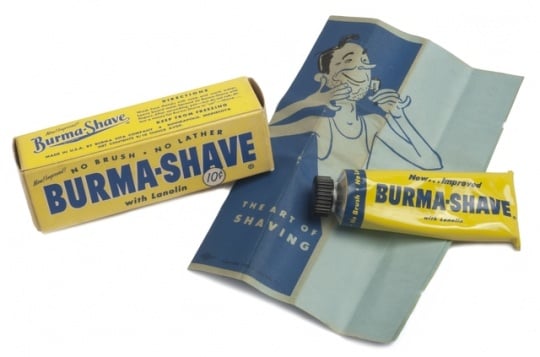
Burma-Shave shaving cream, box, and pamphlet
A nine-ounce aluminum tube of Burma-Shave shaving cream with lanolin, its box, and a pamphlet titled "The Art of Shaving." The box was made in St. Paul, Minnesota, by the Waldorf Paper Products Company between 1954 and 1957.
All rights reserved
Holding Location
Articles
More Information
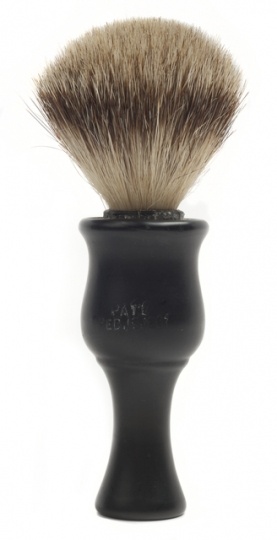
Shaving brush (1888)
Shaving brush with ebony handle and natural bristles. Patented in 1888.
All rights reserved
Holding Location
Articles
More Information
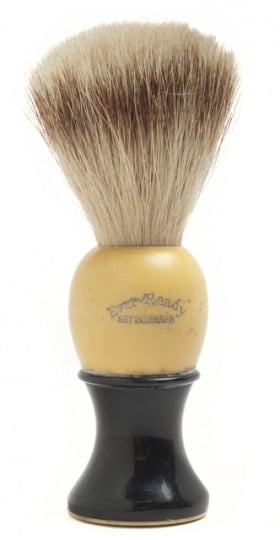
Shaving brush (1930s)
Ever-Ready shaving brush with badger bristles set in a rubber handle. The brush belonged to Arnold W. Becker and was used between 1930 and 1939.
All rights reserved
Holding Location
Articles
More Information
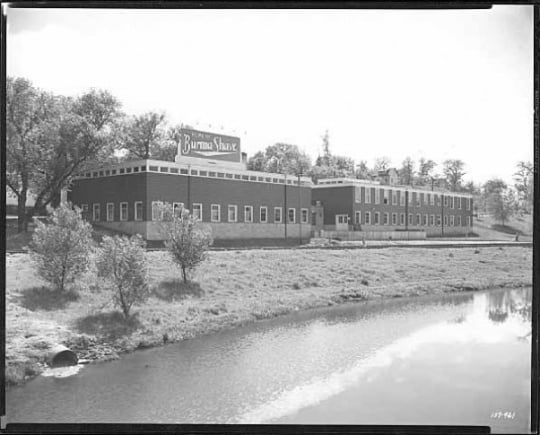
Burma-Vita Company
Burma-Vita Company, 2318 West Chestnut Avenue, Minneapolis. Photograph by Norton & Peel, May 9, 1941.
Holding Location
Articles
More Information
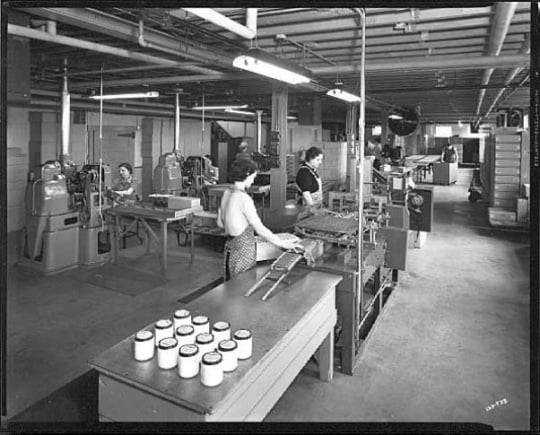
Assembly line inside the Burma-Vita Company
Women working on the assembly line inside the Burma-Vita Company, 2318 Chestnut Avenue West, Minneapolis. Photograph by Norton & Peel, May 9, 1941.
Holding Location
Articles
More Information
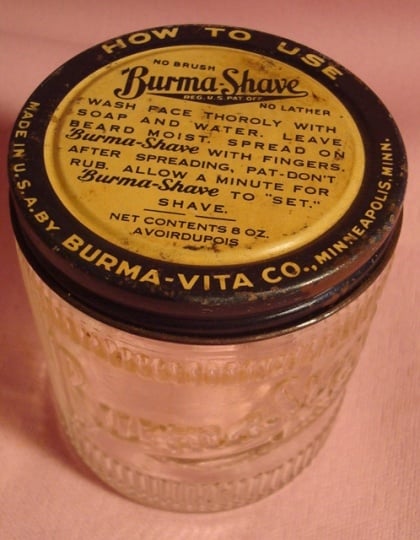
Burma-Shave jar
Burma-Shave jar, ca. 1940s.
Articles
More Information
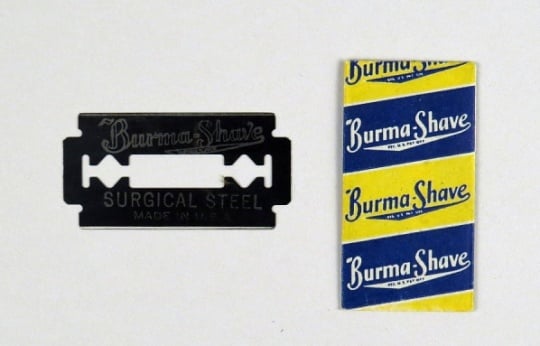
Burma-Shave razor blade
Burma-Shave razor blade, ca. 1940s–1950s.
All rights reserved
Holding Location
Articles
More Information

Burma-Shave sign
A sixth and final sign from a sequential roadside Burma-Shave advertisement, ca. 1940–1955.
All rights reserved
Holding Location
Articles
More Information

Burma-Shave signs
Two multicolored signs advertising Burma-Shave shaving cream. Used by the Burma-Vita Company, ca. 1951–1952.
All rights reserved
Holding Location
Articles
More Information

Burma-Shave signs
Two multicolored signs advertising Burma-Shave shaving cream. Used by the Burma-Vita Company, 1952.
All rights reserved
Holding Location
Articles
More Information

Burma-Shave signs
Two multicolored signs advertising Burma-Shave shaving cream. Used by the Burma-Vita Company between 1951 and 1952.
All rights reserved
Holding Location
Articles
More Information
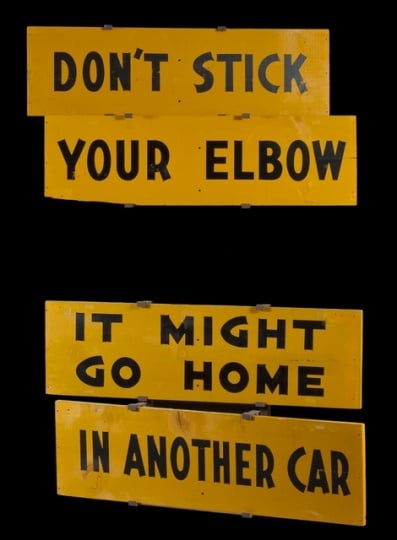
Burma-Shave signs
Four of six original signs from a Burma-Shave sequential roadside advertisement. The middle sign, which would have read "out so far," is missing, as is the sixth and final sign, which would have read, "Burma Shave." Used between 1940 and 1955.
All rights reserved
Holding Location
Articles
More Information
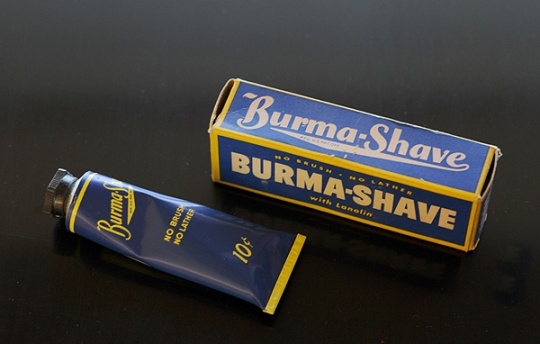
Burma-Shave tube with box
Burma-Shave tube with box, ca. 1950s. Photograph by Wikimedia Commons user Scheinwerfermann, September 3, 2008.
Holding Location
Articles
More Information
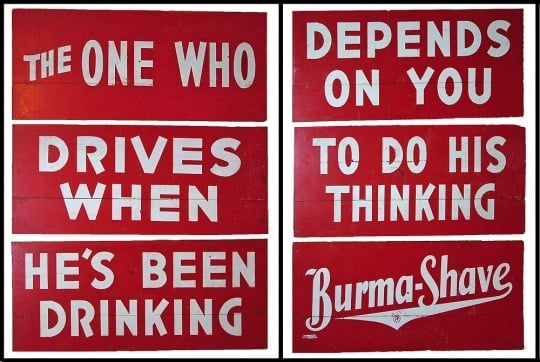
Burma-Shave signs
Series of painted wooden signs advertising Burma-Shave. Manufactured by the Burma-Vita Company, 1959.
All rights reserved
Holding Location
Articles
More Information
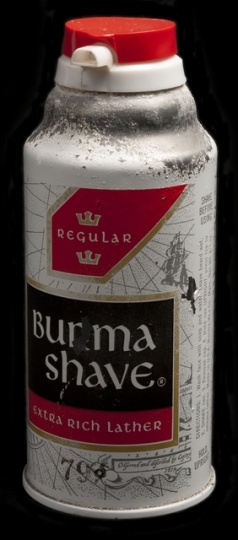
Aerosol can of Burma-Shave
Aerosol can of Burma-Shave shaving cream, 1955–1963.
All rights reserved
Holding Location
Articles
More Information
Turning Point
In 1925, the installation of signs advertising Burma-Shave, the brushless shaving cream, along two Minnesota roads, creates an advertising phenomenon that will last for decades.
Chronology
1926
1926
1935
1950
1953
1960
1963
1963
1965
1968
2017
Bibliography
“Burma-Vita Company Leases New Building.” Minneapolis Sunday Tribune, February 28, 1926.
P1920
Burma-Vita Company Records, 1949–1954
Manuscript Collection, Minnesota Historical Society, St. Paul
Description: Photocopies and original materials removed from a scrapbook (1949–1954) containing newspaper clippings, advertisements from both retail and trade magazines, and contest announcements documenting the nationwide sales efforts of a Minneapolis shaving cream manufacturer.
“Burma Vita Company to Establish Modern Plant in Four-Story Structure.” Minneapolis Sunday Tribune, April 18, 1926.
“Burma-Vita, What is it?” Minneapolis Star Tribune, August 10, 1924.
Esther, John. “The Signs and Rhymes of Burma-Shave.” VHS videotape. Cincinnati: Delaney Communications, 1994.
“Goodbye! Old Shaving Brush.” Minneapolis Sunday Tribune, February 13, 1927.
Gamble Agency Store Advertisement. Pine River Journal, October 31, 1935.
Jacobson, Don. “In the Place of Burma Shave, a New School’s Flag will Wave.” Minneapolis Star Tribune, May 12, 2017.
Rowsome Jr., Frank. The Verse by the Side of the Road: The Story of the Burma-Shave Signs and Jingles. Brattleboro, VT: Stephen Greene Press, 1965.
Vossler, Bill. Burma-Shave: The Rhymes, the Signs, the Times. St. Cloud: North Star Press of St. Cloud, Inc., 2001.
“What! No Lather?” Minneapolis Sunday Tribune, February 26, 1928.
Related Resources
Primary
Dunlop, Richard and Jane. “What Happened to the Burma-Shave Signs?” Home and Away 10, no.4 (1989): 18–19.
Gilsenan, Tom. “Signs Meant Sales: Burma-Shave into the Sixties.” Hennepin History 53, no. 4 (1994): 29–35.
Secondary
Brandt, S. “It May be Razed/Instead of Saved/Say So Long to/Burma Shave.” Minneapolis Star Tribune, October 24, 2015.
Brandt, Steve. “Proposed Demolition of Burma Shave Home Decried.” Minneapolis Star Tribune, July 29, 2016.
Harris, Moira F. “Ho-ho-ho! It Bears Repeating—Advertising Characters in the Land of Sky Blue Waters.” Minnesota History 57, no. 1 (Spring 2000): 23–35.
http://collections.mnhs.org/MNHistoryMagazine/articles/57/v57i01p023-035.pdf
Web
St. Louis Park Historical Society. Carl W. Noren.
http://slphistory.org/norencarl/
US Department of Transportation, Federal Highway Administration, Highway History. How the Highway Beautification Act Became a Law.
https://www.fhwa.dot.gov/infrastructure/beauty.cfm
US Department of Transportation, Federal Highway Administration, Highway History. History of the Interstate Highway System.
https://www.fhwa.dot.gov/interstate/history.cfm
















